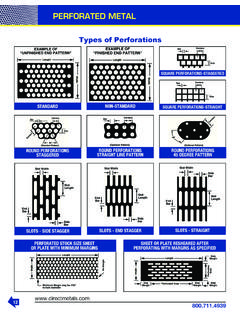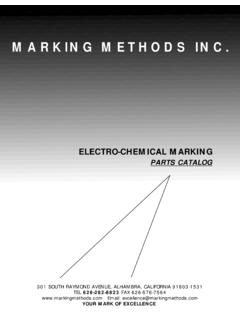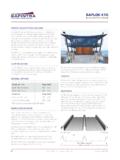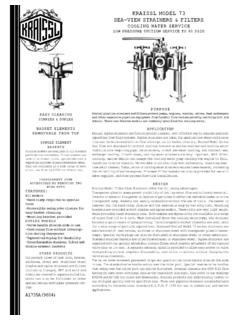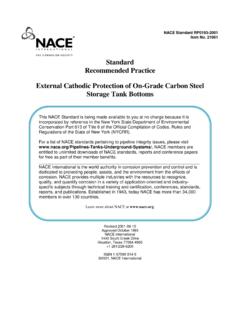Transcription of A Summary for Consultants, Engineers and Architects
1 NIRBC Constructed Wetlands for Northern Ireland The Northern Ireland Reed Bed Company . A Guide to Specifying Reed Beds and Constructed Wetland Systems A Summary for Consultants, Engineers and Architects Introduction Reed Bed Treatment Systems (RBTS) have been in use throughout Europe and North America for many years and have evolved as mainstream techniques in the treatment matrix for many companies and organisations. There are many processes at work within RBTS.
2 Effective design is based on creating the right balance of processes for the required treatment. The various concepts of sustainability, biodiversity, SUDs and environmental good practice can all be incorporated within simple, robust structures which are also visually appealing. RBTS are frequently specified in environmentally sensitive areas and where obtaining planning permission is problematic. There is now sufficient knowledge and data on RBTS to achieve consistent predictions of treatment standards for most applications.
3 Case studies are available from reliable sources which have promoted confidence in the various techniques. What is a Reed Bed? A reed bed is an engineered structure, usually a shallow excavation not more than one meter in depth, into which is laid an impermeable liner. Media, usually clean washed 10mm gravel, is placed within the bed to provide filtering and surface area for bacteria (biofilm) to develop. Water is introduced in the bed via a pipe or dosing system where it stays for a period of time.
4 Various processes take place within the bed, including sedimentation, microbial degradation, and chemical breakdown. The reeds help the process in two main ways. i. The stem transfers oxygen to the active layer around the root structure, which keeps the area aerobic. ii. The roots maintain the spaces between the gravel pieces to maintain a pathway (hydraulic conductivity) for the water. Simple techniques are employed to retain water and control level and flow. Usually, RBTS are designed in sequential stages to treat water to the required standard.
5 Planning and Consent to Discharge (NI Only) Planning Service does not require an application for construction of reed beds as replacement systems for existing treatment for single domestic dwellings only. The entire system should be within the curtilage of the property and may be specified, for example, to replace a failed soakaway. Other reed bed systems may require a planning application. 2 All reed bed applications which discharge water to the environment require a Consent to Discharge certificate from EHS (Water Management Unit).
6 The application process currently takes from three to six months. There are two types of application depending on the type and volume of discharge (Form WO1/WO2). Advice should be sought from EHS (WMU) if required. Types of Reed Bed Construction There are three main types of reed bed construction: i. Surface Horizontal Flow (SHF). This design allows water to flow over the surface of the bed between the stems of the reed plants which are planted in earth. The water is visible, usually to a depth of around 150mm.
7 This design is effective for settling out solids prior to further treatment, or to balance flows into further reed bed stages. SHF reed beds are not generally appropriate for BOD removal because it has limited aerobic capability and little surface contact area for biofilm to develop. ii. Subsurface Horizontal Flow (SSHF). This design allows water to flow below the surface of the reed bed through gravel media. The reed plants are planted in the gravel. There is no visible water in the bed and as such presents no public safety or odour problems.
8 The reed plants are allowed to die back in winter and form a warm composted layer which protects the biofilm below. This design is effective in reducing SS, BOD, COD, and partial ammonia removal. It is also effective in removal of pathogens, hydrocarbons, some heavy metals and nitrates. iii. Down Flow or Vertical Flow (VF). This design requires dosing of the surface of the bed using a network of pipes and either a pumping or a siphon system. The idea is to flood the surface of the reed bed a number of times per day.
9 As the water flows down through the bed it draws air in, creating a highly aerobic environment. VF reed beds are very effective in removal of BOD, ammonia and some heavy metals, and have a smaller footprint for similar treatment compared to SSHF . VF reed beds must be very carefully designed in order to work effectively for extended periods. Of particular importance is the grade and quality of the media in the bed. The efficiency of SSHF and VF reed beds may be improved by adding certain chemicals to the water during the treatment.
10 For example, this technique can be used for COD or phosphorous removal in industrial process water. Some or all of the above basic designs can be incorporated within a treatment system in order to progressively treat water. 3 System Components i. Inlet distribution pipework. The design requirement is to introduce water to the bed in an even and steady flow. Water flowing too fast into the bed will scour the biofilm from the media. Uneven flow across the inlet end in SHF and SSHF will result in short circuiting of the bed.


